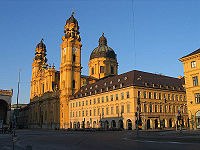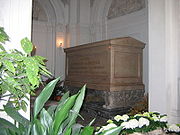
Theatinerkirche (Munich)
Encyclopedia

Theatines
The Theatines or the Congregation of Clerks Regular of the Divine Providence are a male religious order of the Catholic Church, with the post-nominal initials "C.R."-Foundation:...
Church of St. Cajetan (German: Theatinerkirche St. Kajetan) is a Catholic church in Munich
Munich
Munich The city's motto is "" . Before 2006, it was "Weltstadt mit Herz" . Its native name, , is derived from the Old High German Munichen, meaning "by the monks' place". The city's name derives from the monks of the Benedictine order who founded the city; hence the monk depicted on the city's coat...
, southern Germany
Germany
Germany , officially the Federal Republic of Germany , is a federal parliamentary republic in Europe. The country consists of 16 states while the capital and largest city is Berlin. Germany covers an area of 357,021 km2 and has a largely temperate seasonal climate...
. Built from 1663 to 1690, it was founded by Elector Ferdinand Maria
Ferdinand Maria, Elector of Bavaria
Ferdinand Maria, Elector of Bavaria was a Wittelsbach ruler of Bavaria and an elector of the Holy Roman Empire from 1651 to 1679.-Biography:He was born in Munich...
and his wife, Henriette Adelaide of Savoy
Henriette Adelaide of Savoy
Henriette Adelaide of Savoy , was the wife of the Ferdinand Maria, Elector of Bavaria...
, as a gesture of thanks for the birth of the long-awaited heir to the Bavarian crown, Prince Max Emanuel
Maximilian II Emanuel, Elector of Bavaria
Maximilian II , also known as Max Emanuel or Maximilian Emanuel, was a Wittelsbach ruler of Bavaria and an elector of the Holy Roman Empire. He was also the last Governor of the Spanish Netherlands and duke of Luxembourg...
, in 1662.
Architecture
The church was built in Italian high-Baroque style, inspired by Sant'Andrea della ValleSant'Andrea della Valle
Sant'Andrea della Valle is a basilica church in Rome, Italy, in the rione of Sant'Eustachio. The basilica is the general seat for the religious order of the Theatines.-Overview:...
in Rome
Rome
Rome is the capital of Italy and the country's largest and most populated city and comune, with over 2.7 million residents in . The city is located in the central-western portion of the Italian Peninsula, on the Tiber River within the Lazio region of Italy.Rome's history spans two and a half...
, designed by the Italian architect Agostino Barelli
Agostino Barelli
Agostino Barelli was an Italian architect of the Baroque.Barelli was invited to Munich by Henriette Adelaide of Savoy to construct the Theatinerkirche in 1664. The work was cowded by conflicts with the construction supervisor Spinelli. Barelli created also the draft for Nymphenburg Palace in 1664...
. His successor, Enrico Zuccalli
Enrico Zuccalli
Enrico Zuccalli, was a Swiss architect who worked for the Wittelsbach regents of Bavaria and Cologne....
, added two towers, originally not planned, and then finished the 71 meter high dome in 1690. The facade in Rococo style was completed only in 1768 by François de Cuvilliés
François de Cuvilliés
François de Cuvilliés was a Belgian-born Bavarian decorative designer and architect who was instrumental in bringing the Rococo style to the Wittelsbach court at Munich and to Central Europe in general.Cuvilliés was so diminutive in stature that it was as a court dwarf he first came to the notice...
. Its Mediterranean appearance and yellow coloring became a well known symbol for the city and had much influence on Southern German Baroque
Baroque
The Baroque is a period and the style that used exaggerated motion and clear, easily interpreted detail to produce drama, tension, exuberance, and grandeur in sculpture, painting, literature, dance, and music...
architecture.
The interior has a rich stucco decoration, executed by Nicolò Petri (1685–1688), Wolfgang Leutner being responsible for the stucco figures. The great black pulpit is a work of Andreas Faistenberger (1686). The altars house paintings of Caspar de Crayer
Caspar de Crayer
Gaspar de Crayer , sometimes called Gaspard or Caspar de Crayer was a Flemish painter.Crayer was born in Antwerp. He learned the art of painting from Michael Coxcie. He matriculated in the Guild of St Luke at Brussels in 1607, resided in the capital of Brabant till after 1660, and finally settled...
, Carlo Cignani
Carlo Cignani
Carlo Cignani was an Italian painter of the Bolognese and of the Forlivese school, active in the Baroque period....
, George Desmareés and Joachim Sandrart. Balthasar Ableithner created the statues of Saint Marcus and Saint John.
Burial places
A small chapel contains the tombs of King Maximilian IIMaximilian II of Bavaria
Maximilian II of Bavaria was king of Bavaria from 1848 until 1864. He was son of Ludwig I of Bavaria and Therese of Saxe-Hildburghausen.-Crown Prince:...
and his consort Queen Marie
Marie of Prussia
Marie of Prussia was Queen of Bavaria and the mother of Kings Ludwig II and Otto of Bavaria.-Life:Born and raised in Berlin, she was the daughter of Prince Wilhelm of Prussia, a younger brother of King Friedrich Wilhelm III of Prussia, and his wife Landgravine Marie Anna of Hesse-Homburg...
. The crypt also contains the Prince’s Tomb, where among others these members of the Wittelsbach
Wittelsbach
The Wittelsbach family is a European royal family and a German dynasty from Bavaria.Members of the family served as Dukes, Electors and Kings of Bavaria , Counts Palatine of the Rhine , Margraves of Brandenburg , Counts of Holland, Hainaut and Zeeland , Elector-Archbishops of Cologne , Dukes of...
family were buried:

- Princess Henriette Adelaide of Savoy
- Ferdinand Maria, Elector of BavariaFerdinand Maria, Elector of BavariaFerdinand Maria, Elector of Bavaria was a Wittelsbach ruler of Bavaria and an elector of the Holy Roman Empire from 1651 to 1679.-Biography:He was born in Munich...
- Maximilian II Emanuel, Elector of BavariaMaximilian II Emanuel, Elector of BavariaMaximilian II , also known as Max Emanuel or Maximilian Emanuel, was a Wittelsbach ruler of Bavaria and an elector of the Holy Roman Empire. He was also the last Governor of the Spanish Netherlands and duke of Luxembourg...
- Charles VII, Holy Roman EmperorCharles VII, Holy Roman EmperorCharles VII Albert a member of the Wittelsbach family, was Prince-elector of Bavaria from 1726 and Holy Roman Emperor from 24 January 1742 until his death in 1745...
- Maximilian III, Elector of BavariaMaximilian III, Elector of BavariaMaximilian III Joseph was Prince-elector of the Holy Roman Empire and Duke of Bavaria from 1745 to 1777.-Biography:...
- Charles Theodore, Elector of BavariaCharles Theodore, Elector of BavariaCharles Theodore, Prince-Elector, Count Palatine and Duke of Bavaria reigned as Prince-Elector and Count palatine from 1742, as Duke of Jülich and Berg from 1742 and also as Prince-Elector and Duke of Bavaria from 1777, until his death...
- King Maximilian I Joseph of Bavaria
- King Otto of GreeceOtto of GreeceOtto, Prince of Bavaria, then Othon, King of Greece was made the first modern King of Greece in 1832 under the Convention of London, whereby Greece became a new independent kingdom under the protection of the Great Powers .The second son of the philhellene King Ludwig I of Bavaria, Otto ascended...
- Luitpold, Prince Regent of BavariaLuitpold, Prince Regent of BavariaLuitpold, Prince Regent of Bavaria , was the de facto ruler of Bavaria from 1886 to 1912, due to the incapacity of his nephews, King Ludwig II and King Otto.-Early life:...
- Princess Alexandra of BavariaPrincess Alexandra of BavariaPrincess Alexandra Amalie of Bavaria was a member of the House of Wittelsbach and devoted her life to literature.-Early life:...
- Rupprecht, Crown Prince of BavariaRupprecht, Crown Prince of BavariaRupprecht or Rupert, Crown Prince of Bavaria was the last Bavarian Crown Prince.His full title was His Royal Highness Rupprecht Maria Luitpold Ferdinand, Crown Prince of Bavaria, Duke of Bavaria, of Franconia and in Swabia, Count Palatine of the Rhine...
- Duchess Maria Anna Josepha of BavariaDuchess Maria Anna Josepha of BavariaMaria Anna Josepha of Bavaria was a Duchess of Bavaria by birth and Margravine of Baden-Baden by marriage. She was nicknamed the savior of Bavaria. She is also known as Maria Josepha and is sometimes styled as a princess of Bavaria.-Biography:Maria Anna Josepha was born at the Nymphenburg Palace...
- Duchess Marie Gabrielle in BavariaDuchess Marie Gabrielle in Bavaria-Family:Her parents were Duke Karl-Theodor in Bavaria, kinsman to the Kings of Bavaria and world renowned ophthalmologist, and his second wife, Princess Maria José of Bragança, a daughter of King Miguel I, exiled monarch of Portugal...

